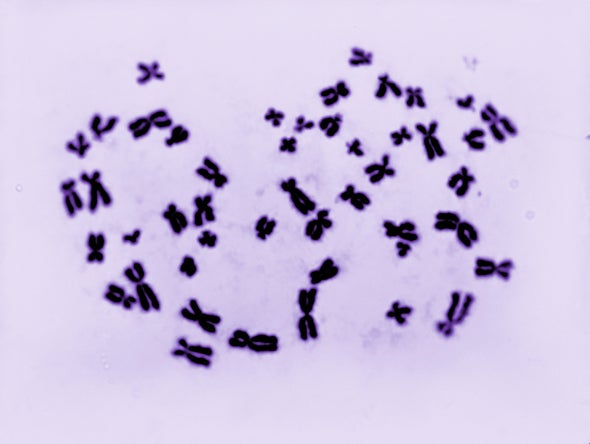For the first time scientists have created two lines of human cells that are identical aside from their sex chromosomes: one has XX chromosomes, and one has XY. This unique set of cells could help researchers answer long-standing questions about how sex chromosomes affect disease and the roles they play in early development.
Most people have two sex chromosomes, either two X's or an X and a Y, which give rise to a spectrum of female or male biological attributes. Studies suggest these chromosomes contribute to processes including immune system function, brain development, disease susceptibility and reactions to drugs. But scrutinizing the specific role of X and Y chromosomes is challenging. With current tools, it is difficult to disentangle the effects of chromosomes versus hormones, for example. These cells could offer a new way to do so.
“This is a really cool set of cell lines,” says Northwestern University pharmacologist Barbara Stranger, who was not involved in the new project. “We've had cell lines from males and females before, but the fact that they're coming from the same person with just [a] sex chromosome difference—it's a big step.”
Benjamin Reubinoff, a developmental biologist at the Hadassah Medical Center in Israel, and his team hope their project will lead to better investigations of human sex differences. Currently two major barriers exist, according to Reubinoff: the difficulty of separating chromosomal and hormonal effects and the inability to pinpoint the effects of X and Y chromosomes while ruling out contributions from the rest of a person's genetic makeup. “There have been animal models, but a model in humans was not available,” Reubinoff says.
To create such a model, Reubinoff, his former M.D. and Ph.D. student Ithai Waldhorn, and their colleagues first obtained white blood cells previously collected from a person with Klinefelter syndrome. This condition describes male individuals born with an extra X chromosome, meaning their cells hold two X chromosomes and one Y. The white blood cells came from the repositories of the Coriell Institute for Medical Research, where people donate samples for use in biomedical research projects. The donor had a rare “mosaic” form of the condition, in which some of their cells had three sex chromosomes (XXY), some had two X chromosomes, and some had one X and one Y. The researchers reprogrammed all three cell types into induced pluripotent stem cells, which are in an embryonic state and can develop into neurons, muscle or other cell types.
Ultimately the team generated XX and XY cells that—apart from their sex chromosomes—were genetically identical. The researchers then conducted a series of experiments replicating findings from prior studies. For example, they confirmed previously reported differences in genes that were turned on in XX or XY cells. And when they coaxed the induced pluripotent stem cells to develop into immature versions of neurons, they found evidence of previously documented sex differences in early neural development. “It was reassuring to see that the model really shows differences between the sexes that were reported from other systems,” Reubinoff says. The findings were published in Stem Cell Reports.
“This is a very well-designed study that validates the notion that sex differences start early in development—and that they depend on the sex chromosomes, because that's the only thing that can account for those differences,” says Nora Engel, a cell biologist and cancer researcher at Temple University, who was not involved in the new study.
In the past, researchers have probed the effects of sex chromosomes in animals using the “four core genotypes” mouse model, which includes manipulating a gene usually found within the Y chromosome called Sry. This gene contains instructions for developing testes, and the process creates animals with XX chromosomes and testes or XY chromosomes and ovaries. Animals with the same sex organs but different chromosomes let scientists distinguish the chromosomes' effects from those of sex hormones, which are secreted by the reproductive organs. The mouse model was transformative for the field of sex difference research, Stranger says, and being able to move this research into humans “is really neat.”
“I think this is going to open up avenues for new research,” says Jessica Abbott, an evolutionary geneticist at Lund University in Sweden, who was not involved in the research. Abbott notes that it will be important to derive XX and XY stem cells from another person to see how much variation there is between individuals—which will help determine whether the findings from these cells can be generalized to the broader population.
Cells, of course, cannot model the entire human body or interactions between organs—at least not yet. But Reubinoff notes that with the development of new techniques, such as microfluidic “body on a chip” systems that replicate the connections between cells from different organs, scientists may soon be able to address a broader array of research questions. For now Reubinoff is excited about the experiments that will be possible with stem cells alone. “You have a tool that you can, at least theoretically, use [indefinitely to] generate any cell type and develop models for various types of diseases,” he says. “The model we developed opens wide horizons.”


